Python基础知识大全(适用于全面复习Python语法知识)
posted on 2023-06-06 10:55 read(1099) comment(0) like(3) collect(2)
Types of python language
python is an interpreted language
Source code (python) <-> interpreter (interpret each sentence of source code line by line) <-> operating system <-> cpu
Java is a compiled language
Source code (java)->compiler->executable file->operating system<->cpu
Basic types of python language data
Confusing forms of expression
Tuples ( ) are similar to lists [ ] except that tuples cannot be modified. These two are somewhat similar to arrays in C language
The only set { } is similar to a dictionary except that there is no values. The key in the dictionary must be an immutable type, and the dictionary lookup speed is fast. The disadvantage is that it takes up memory. The elements in the same set are immutable, so there cannot be a list.
Mutable and immutable sequences
The criterion for distinguishing mutable sequence sequences from immutable sequences is whether the sequence can be added, deleted, or modified; and the address of the object after the addition, deletion, or modification operation does not change. A sequence that can be added, deleted, or modified is called a mutable sequence. Conversely, a sequence that cannot be added, deleted, or modified is called an immutable sequence.
Mutable sequences: lists, dictionaries, sets
Immutable sequences: numbers, strings, tuples
the list
definition
List (list) is the most frequently used data type in Python. It is usually called an array in other languages, and it is specially used to store a set of data.
#第一种方式
name_list = [] OR name_list = ['tom','jack']
#第二种方式
data_list = list()
ps: It is equivalent to the array in C language, except that the array in C language stores the same type of data
count
data_list = ['python', 'java', 'python', 'php']
print(data_list.count("python")) #2
index[] list can use index to use data
name_list = ['张三', '李四']
print(name_list[0]) # 张三
print(name_list[1]) # 李四
append(data) insert data at the end
val_list = ["Web自动化", "UI自动化", "接口自动化"]
val_list.append("APP自动化")
print(val_list)
# ['Web自动化', 'UI自动化', '接口自动化', 'APP自动化']
ps:
可以插入的各种不同类型的数据 比如数字 字典 元组
extend()
Use a new sequence to extend the current sequence, requires a sequence as a parameter, it will add the elements in the sequence to the current list
stus.extend(['唐僧','白骨精']) 相当于
stus += ['唐僧','白骨精']
clear()
stus = ['孙悟空','猪八戒','沙和尚','唐僧']
stus.clear() #清空序列 []
insert(position, data)
abc = ['yinsheng', 'jiayou', 1111, (11, 22, 33), {'abc': 456}]
abc.insert(0,{“key”:1})
print(abc)
#[{'key': 1}, 'yinsheng', 'jiayou', 1111, (11, 22, 33), {'abc': 456}]
remove()
# 删除指定值得元素,如果相同值得元素有多个,只会删除第一个
stus = ['孙悟空','猪八戒','沙和尚','唐僧','猪八戒']
stus.remove('猪八戒')
print(stus) #['孙悟空','沙和尚','唐僧','猪八戒']
pop (list index number) delete a data
val_list = ["Web自动化", "UI自动化", "接口自动化"]
val = val_list.pop(0)
print(val, val_list)
# web自动化,['UI自动化', '接口自动化']
ps:
不指定位置号 那么默认删除最后一个
to sort
reverse() reverses the list
my_list = [10,1,20,3,4,5,0,-2]
print('修改前',my_list) #[10,1,20,3,4,5,0,-2]
my_list.reverse()
print('修改后',my_list) #[-2, 0, 5, 4, 3, 20, 1, 10]
sort() default reverse=false
sort(reverse=true) #descending
sort(reverse=false) # ascending order
val_list = [8, 100, 30, 10, 40, 2]
val_list.sort(reverse=True)
print(val_list) # [100, 40, 30, 10, 8, 2]
val_list.sort()
print(val_list) #[2, 8, 10, 30, 40, 100]
sorted() Temporary sorting
val_list = [8, 100, 30, 10, 40, 2]
b= sorted(val_list)
print(val_list) #[8, 100, 30, 10, 40, 2]
print(b) #[2, 8, 10, 30, 40, 100]
nesting
student_list = [["张三", "18", "功能测试"], {"key":1,"key1":2},(11,222,333)]
print(student_list[1]["key1"]) #2
print(student_list[0][1]) # 18
print(student_list[2][1]) #222
tuple
ps: It is almost the same as the list list, except that it cannot be modified, but this cannot be modified, which means that the pointer will never change
for example
t = ('a', 'b', ['A', 'B'],111,(2,3,4),{"key":1})
t[2][0] = 'x'
t[2][1] = 'y'
t[5]["key"]=2
print(t)
#('a', 'b', ['x', 'y'], 111, (2, 3, 4), {'key': 2})
definition
Tuples, like lists, can be used to store multiple data, the difference is that the elements of tuples cannot be modified
#第一种方式
user_info = () OR name_list = ('zhangsan',18,1.75)
#第二种方式
info_tuple = tuple()
ps:元组中只包含一个元素时,需要在元素后面添加逗号
如 data=(1,)
Check (by index)
tuple1 = (1, 2, 3)
print(tuple1[1]) # 2
count
tuple1 = (1, 2, 3)
print(tuple1.count(3)) # 1
unpack
A special use of tuples: swapping the values of two variables
num1 = 100
num2 = 200
num2,num1 = num1,num2
print(num1) #200
print(num2) #100
ps:
1.在Python中可以使用对应数据个数的变量,获取对应元组数据中的每一个元素
2.在Python中定义多个元素的元组数据时,小括号可以省略
3.借助以上两个特性,可以通过元组快速实现交换两个变量的值
unpack
my_tuple = 10 , 20 , 30 , 40
a , b , *c = my_tuple
print(a,b,c) #10 20 [30, 40]
a , *b , c = my_tuple
print(a,b,c) #10 [20, 30] 40
*a , b , c = my_tuple
print(a,b,c) #[10, 20] 30 40
Notice
ps:
# 当元组不是空元组时,括号可以省略
# 如果元组不是空元组,它里边至少要有一个,
dictionary
definition
test = dict()
test2 = {}
d = dict(name1='孙悟空',age1=18,gender1='男')
print(d) #{'name1': '孙悟空', 'age1': 18, 'gender1': '男'}
#利用双值子序列
d = dict([('name','孙悟饭'),('age',18)])
print(d) #{'name': '孙悟饭', 'age': 18}
Add and modify dictionary[key]=value
info = {
"name": "tom",
"age": 18
}
info["salary"] = 100000
print(info) # {'name': 'tom', 'age': 18, 'salary': 100000}
pop(key) delete
info = {
"name": "tom",
"age": 18,
"gender": "男" }
info.pop("gender")
print(info) # {'name': 'tom', 'age': 18}
get(key) query
info = {
"name": "tom",
"age": 18,
"gender": "男" }
print(info.get("name")) # tom
print(info.get("abc")) # None
for key in dictionary.keys()
#遍历得到所有键名
info = {
"name": "tom",
"age": 18,
"gender": "男" }
for key in info.keys():
print(key)
for value in dictionary.values():
#遍历得到所有的键对应的值
info = {
"name": "tom",
"age": 18,
"gender": "男" }
for value in info.values():
print(value)
for k, v in dictionary.items():
#遍历得到所有的键和值
info = {
"name": "tom",
"age": 18,
"gender": "男" }
for k, v in info.items():
print(f"key={k} value={v}")
some common methods
setdefault(key, default]) can be used to add key-value to the dictionary
#如果key已经存在于字典中,则返回key对应的value值,不会对字典做任何操作
#如果key不存在,则向字典中添加这个key,并设置value
d = dict([('name','孙悟饭'),('age',18)])
result = d.setdefault('name1','猪八戒')
result2 = d.setdefault('name','11111')
print(result) #猪八戒
print(result2) #孙悟饭
print(d) #{'name': '孙悟饭', 'age': 18, 'name1': '猪八戒'}
update()
#将其他的字典中的key-value添加到当前字典中
#如果有重复的key,则后边的会替换到当前的
d = {'a':1,'b':2,'c':3}
d2 = {'d':4,'e':5,'f':6, 'a':7}
d.update(d2)
print(d) #{'a': 7, 'b': 2, 'c': 3, 'd': 4, 'e': 5, 'f': 6}
of the
d = {'a': 7, 'b': 2, 'c': 3, 'd': 4, 'e': 5, 'f': 6}
del d['a']
print(d) #{'b': 2, 'c': 3, 'd': 4, 'e': 5, 'f': 6}
del d['e']
print(d) #{'b': 2, 'c': 3, 'd': 4, 'f': 6}
drink()
#随机删除字典中的一个键值对,一般都会删除最后一个键值对
#删除之后,它会将删除的key-value作为返回值返回
#返回的是一个元组,元组中有两个元素,第一个元素是删除的key,第二个是删除的value
#当使用popitem()删除一个空字典时,会抛出异常 KeyError
d = {'b': 2, 'c': 3, 'd': 4, 'f': 6}
result = d.popitem()
print(result) # ('f', 6)
print(d) # {'b': 2, 'c': 3, 'd': 4}
copy()
# 该方法用于对字典进行浅复制
# 复制以后的对象,和原对象是独立,修改一个不会影响另一个
# 注意,浅复制会简单复制对象内部的值,如果值也是一个可变对象,这个可变对象不会被复制 意味着修改了这个可变对象的值之后 两个地方的值均变化 因为它不独立
d = {'a':{'name':'孙悟空','age':18},'b':2,'c':3}
d2 = d.copy()
print(d2) # {'a': {'name': '孙悟空', 'age': 18}, 'b': 2, 'c': 3}
d2['a']['name'] = '测试一想'
d2['b']=6
print(d2) # {'a': {'name': '测试一想', 'age': 18}, 'b': 6, 'c': 3}
print('d = ',d , id(d)) #d = {'a': {'name': '测试一想', 'age': 18}, 'b': 2, 'c': 3} 2363954785808
print('d2 = ',d2 , id(d2)) #d2 = {'a': {'name': '测试一想', 'age': 18}, 'b': 6, 'c': 3} 2363954786168
clear()
d = {'b': 2, 'c': 3, 'd': 4}
d.clear() #{}
in not in
Notice
字典的值可以是任意对象
字典的键可以是任意的不可变对象(int、str、bool、tuple ...),但是一般我们都会使用str
字典的键是不能重复的,如果出现重复的后边的会替换到前边的
gather
definition
a = set()
print(type(a))
a = {1,3,4}
print(type(a))
Convert a list-string-dictionary-tuple into a set
s = set([1,2,3,4,5,1,1,2,3,4,5])
print(s) # {1, 2, 3, 4, 5}
s = set('hello')
print(s) # {'l', 'o', 'e', 'h'}
s = set({'a':1,'b':2,'c':3})
print(s) # {'a', 'b', 'c'}
s = (1,2,3,4)
print(set(s)) # {1, 2, 3, 4}
common method
in not in
Use in and not in to check elements in a collection
s = {'a' , 'b' , 1 , 2 , 3 , 1}
print('c' not in s) #True
print('a' in s) #True
add()
s = {'a' , 'b' , 1 , 2 , 3 , 1}
s.add(10)
print(s) #{1, 2, 3, 'a', 10, 'b'}
update()
update() Adds elements from a collection to the current collection
update() can pass a sequence or a dictionary as a parameter, and the dictionary will only use the key
s = {'a' , 'b' , 1 , 2 , 3 , 1}
s2 = set('hello')
s.update(s2)
print(s) #{1, 2, 3, 'o', 'e', 'a', 'h', 'b', 'l'}
s.update((10,20,30,40,50))
print(s) #{1, 2, 3, 'o', 40, 10, 'e', 'a', 'h', 50, 20, 30, 'b', 'l'}
s.update({10:'ab',20:'bc',100:'cd',1000:'ef'})
print(s) #{1, 2, 3, 100, 'o', 40, 10, 'e', 1000, 'a', 'h', 50, 20, 30, 'b', 'l'}
pop()
pop() randomly deletes and returns an element in a collection
s = {'a' , 'b' , 1 , 2 , 3 , 1}
result = s.pop()
print(result) #1
print(s) #{2, 3, 'a', 'b'}
remove()
s = {'a' , 'b' , 100 , 2 , 3 , 100}
s.remove(100)
print(s) # {2, 3, 'b', 'a'}
clear()
copy() # make a shallow copy of the collection
operations on sets
&
s = {1,2,3,4,5}
s2 = {3,4,5,6,7}
# & 交集运算
result = s & s2
print(result) # {3, 4, 5}
|
s = {1,2,3,4,5}
s2 = {3,4,5,6,7}
# | 并集运算
result = s | s2
print(result) # {1,2,3,4,5,6,7}
s = {1,2,3,4,5}
s2 = {3,4,5,6,7}
# - 差集
result = s - s2
print(result) # {1, 2}
^
s = {1,2,3,4,5}
s2 = {3,4,5,6,7}
# ^ 异或集 获取只在一个集合中出现的元素
result = s ^ s2
print(result) # {1, 2, 6, 7}
<=
<= checks if a set is a subset of another set
If all the elements in set a appear in set b, then set a is a subset of set b, and set b is a superset of set a
a = {1,2,3}
b = {1,2,3,4,5}
result = a <= b # True
result = {1,2,3} <= {1,2,3} # True
result = {1,2,3,4,5} <= {1,2,3} # False
<
< checks if a set is a proper subset of another set
If the superset b contains all the elements in the subset a, and there are elements in b that are not in a, then b is a proper superset of a, and a is a proper subset of b
result = {1,2,3} < {1,2,3} # False
result = {1,2,3} < {1,2,3,4,5} # True
greater than and >=
# >= 检查一个集合是否是另一个的超集
# > 检查一个集合是否是另一个的真超集
general method
Contains string (str) tuple (tuple) list (list)
slice operation
ps: Lists, tuples, and strings can all be sliced, collections and dictionaries cannot be sliced
data[start index: end index: step]
name = "abcdefg"
print(name[2:5:1]) # cde
print(name[2:5]) # cde
print(name[:5]) # abcde
print(name[1:]) # bcdefg
print(name[:]) # abcdefg
print(name[::2]) # aceg
print(name[:-1]) # abcdef, 负1表示倒数第一个数据print(name[-
4:-1]) # def
print(name[::-1]) # gfedcba
only
str_data = "hello python"
print(len(str_data)) # 12: 字符中字符个数(包含空格)
list_data = ["python", "java"]
print(len(list_data)) # 2: 列表中元素个数
tuple_data = ("admin", 123456, 8888)
print(len(tuple_data)) # 3: 元组中元素个数
dict_data = {"name": "tom", "age": 18, "gender": "男"}
print(len(dict_data)) # 3: 字典中键值对的个数
Addition, subtraction, multiplication and division are not all
Strings and lists and tuples can + * dictionaries and sets cannot
in or not in
max() min()
count() does not work for dictionaries and collections
index_1 = '123'
print(index_1.count('1')) #1
index_1 = [1,2,3]
print(index_1.count(1)) #1
index_1 = (1,2,3)
print(index_1.count(1)) #1
index() does not work for dictionaries and collections
index_1 = (1,2,3)
print(index_1.index(1)) #0
index_1 = [1,2,3]
print(index_1.index(3)) #2
index_1 = 'abc'
print(index_1.index('b')) #1
function
The syntax format of the definition:
Function names follow the identifier naming rules: letters, numbers, underscores, cannot start with a number, and do not use system keywords
def is the abbreviation of English define
The function name should preferably be able to express the function of the code encapsulated inside the function, so as to facilitate subsequent acquisition and invocation [see name to know]
def 函数名():
函数封装的代码
Modules and Packages
A py file is a module
A package is a special directory containing multiple modules
default function, multivalued function, anonymous function
default function
def print_info(name, title="", gender="男生"):
print(f"{title}{name} 是 {gender}")
# 提示:在指定缺省参数的默认值时,应该使用最常见的值作为默认值!
print_info("小明") #小明 是 男生
print_info("老王", title="班长") #班长老王 是 男生
print_info("小美", gender="女生") #小美 是 女生
multivalued function
def demo(num, *args):
print(num)
print(args)
demo(1, 2, 3, 4, 5) # 1换行 (2, 3, 4, 5)
def sum_numbers(*args):
num = 0
# 遍历 args 元组求和
for n in args:
num += n
return num
nums = (1, 2, 3)
result = sum_numbers(*nums)
print(f"result={result}") #result=6
anonymous function
user_list = [
{'name': '张三', 'age': 22, 'title': '测试工程师'},
{'name': '李四', 'age': 24, 'title': '开发工程师'},
{'name': '王五', 'age': 21, 'title': '测试工程师'}
]
# 按照age进行排序
user_list.sort(key=lambda m: m["age"])
print(user_list)
Basic step-by-step practice begins
coding
In the beginning, ANSI used almost 1 byte encoding for the 26 English words in the United States, so the range is 256
After that, we have Chinese in China, Japan, Japanese, Korea, and Korean, and so on, all of which have corresponding codes, but this is too messy.
So unicode came into being and uses 2-byte encoding, but this is a waste of space for those English letters that only need 1-byte encoding
So utf-8 came into being. UTF-8 encoding is used to encode a Unicode character into 1-6 bytes according to different number sizes. For English, 1 byte is encoded. Chinese is usually 3 bytes, which is particularly remote. 4-6 bytes
内存中的编码都是unicode 最后存储的时候转化为utf-8存储
编码 decode 主要是编成 unicode
解码 encode 主要是解编成 utf-8
格式化
格式化的四种形式
name = 'yinsheng'
print('欢迎 '+name+' 光临!')
# 多个参数
print('欢迎',name,'光临!')
# 占位符
print('欢迎 %s 光临!'%name)
# 格式化字符串
print(f'欢迎 {name} 光临!')
迭代
for 循环 也称为 迭代
列表生成式
[x*x for x in range(0,10)]
其实 字典也可以 {x*x for x in range(0,10)}
生成器
列表生成式 换成元组 其实就是 生成器了
g=(x*x for x in range(0,10))
然后通过 next(g) 或者for循环来 for x in g :
还可以弄成函数形式 其中 field就是一个标志
迭代器
生成器的对象 一定是迭代器
字典、集合 列表、元组 字符串 不是迭代器 但是可以通过iter()函数变成迭代器
字典 集合 列表 元组 字符串 生成器 都是可迭代的
返回值_闭包
闭包 就是 函数里面返回函数
调用闭包 创建的函数哪怕一模一样 也不相等
注意闭包函数 里面调用的变量 比如 i 这种有变化的 用函数封装 不要用 for 循环
里面 引用外面的变量要赋值的话 注意nonlocal 声明变量
访问限制
__开头的变量和函数 类外面调用不了
_开头的变量和函数 类外面可以调用 但是不要调用 它已经代表私有的意思在里面了
而要调用以及修改 则类要多加两个函数 get调用获取 和set 修改
继承和多态
当我们定义一个class的时候,我们实际上就定义了一种数据类型。我们定义的数据类型和Python自带的数据类型,比如str、list、dict没什么两样: ---------<廖雪峰>
继承(ocp原则 保持代码不变但是可扩展)
多重继承(排在前面的方法会覆盖后面的方法) 比如
class A(B,C):
pass
假如B和C中都有test方法 B中的test方法优先调用 相当于覆盖率C中的test方法
私有属性和私有方法
当属性和方法只需要在类定义内部使用时,就可以使用私有属性和私有方法特点:在类定义外部,无论是通过类对象还是实例对象均无法获取私有属性和调用私有方法
获取对象信息
dir 获取属性和方法
getattr 获得属性名称的值 getattr(obj,属性名称)
setattr 建立属性 setattr(obj,属性名称,值)
hasattr 判断是否有属性 hasattr(obj,属性名名称)
异常处理
Built-in Exceptions — Python 3.10.5 documentation
捕获异常 try: exception finally
1捕获成功 打印出对应的提示信息
2没有捕获成功 则一层一层抛出错误的信息 要学会定位到真正的地方 且接下来的不会执行 要想有错误信息且执行后面的语句 就要借助logging模块 logging.exception(错误信息)
抛出异常
1.捕获之后 也可以抛出异常
2.抛出的异常和捕获的异常不一样 相当于转化了异常错误类型
进制转换
二进制转十进制 用 int(a,2)
八进制 16进制转十进制 用int(a,8) int(a,16)
十进制转二进制 bin(a)
十进制转八进制 oct(a)
十进制转16进制 hex(a)
python一些内在的原理图片
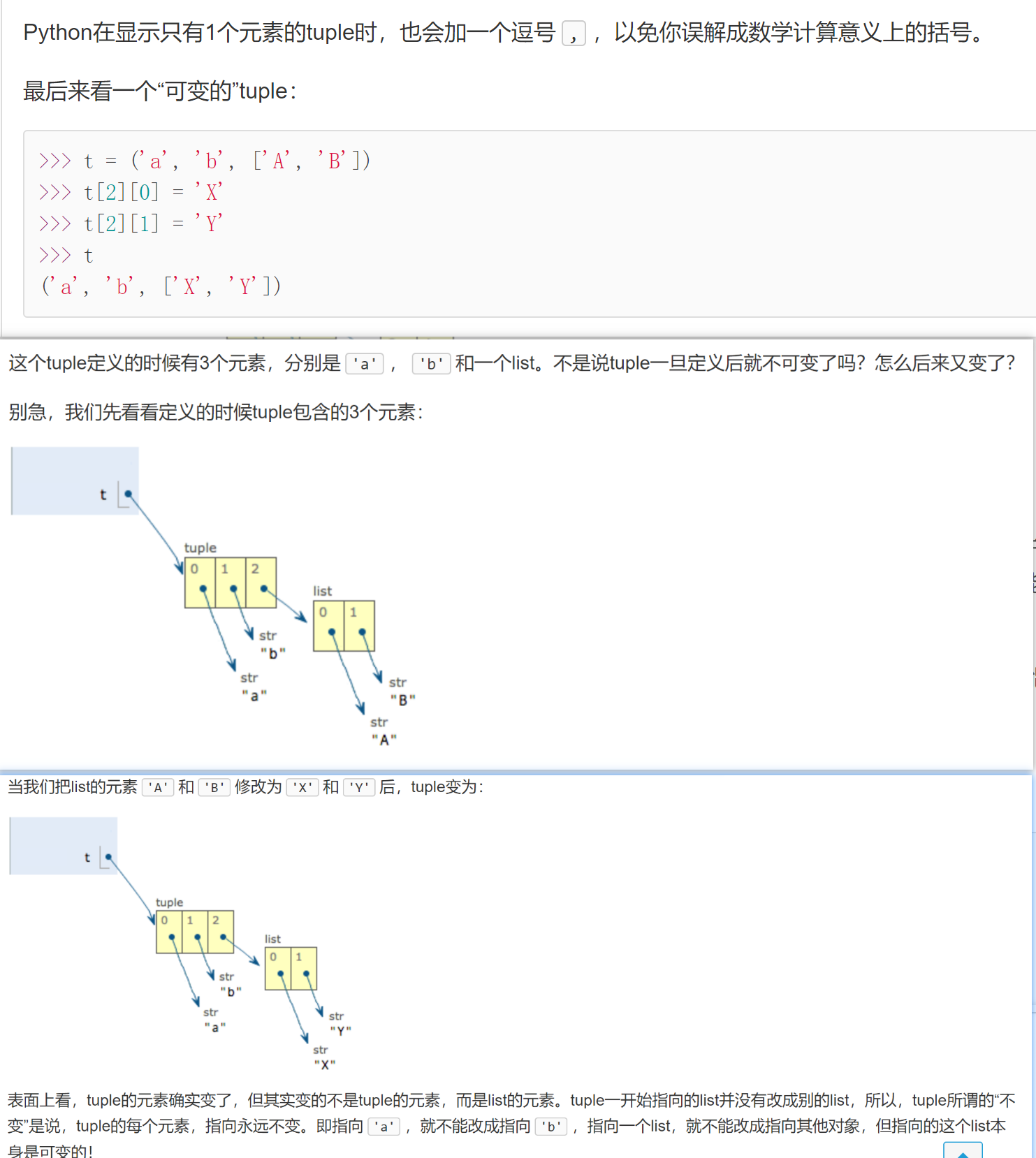
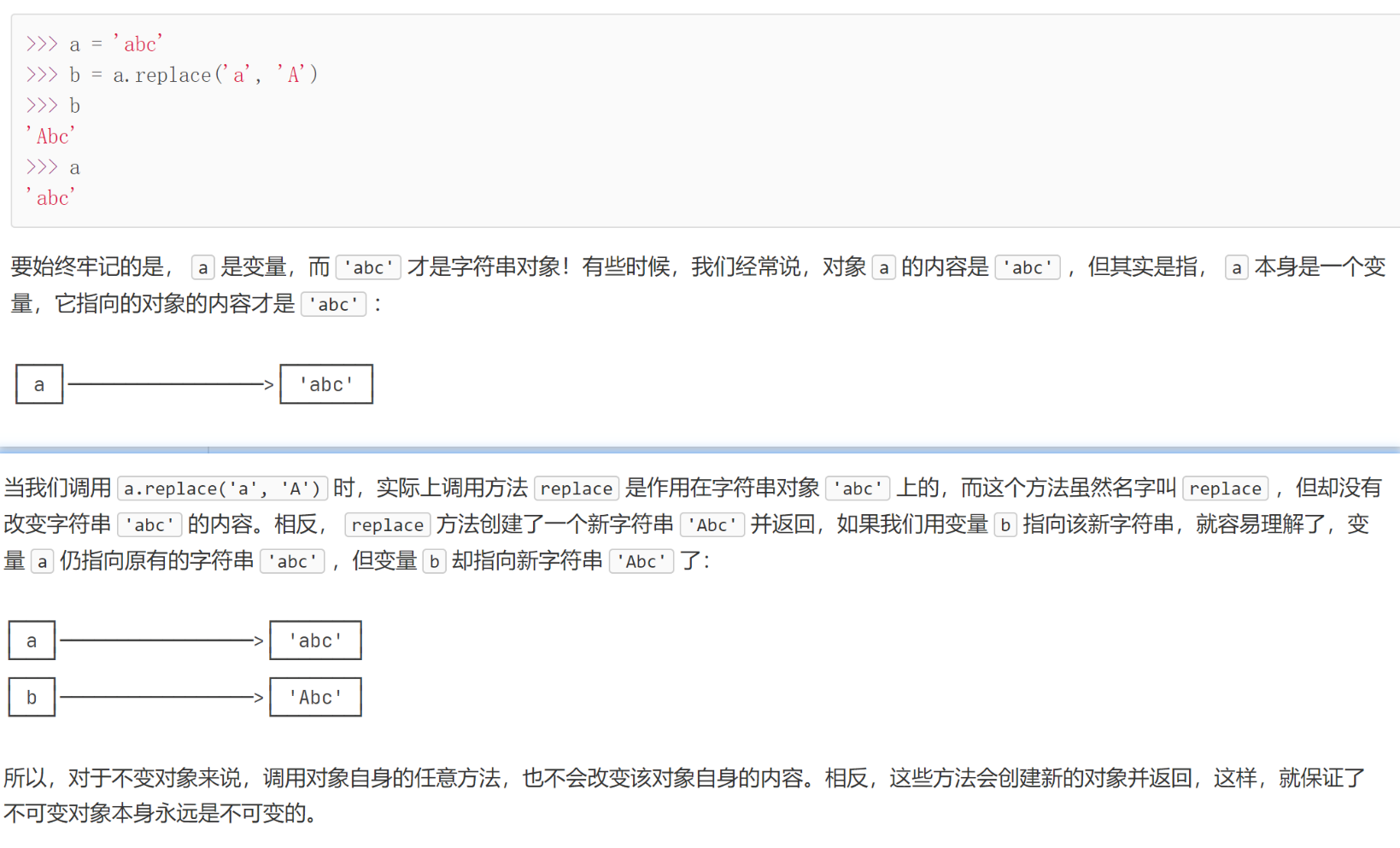
正则表达式
Python3 正则表达式特殊符号及用法(详细列表) - alanminmin - 博客园 (cnblogs.com)
lesson_尚硅谷
数值
Python数值分成了三种:整数、浮点数(小数)、复数
Python中的整数的大小没有限制,可以是一个无限大的整数
如果数字的长度过大,可以使用下划线作为分隔符
python 二进制表现形式 0b 开头 八进制表现形式 0o开头 十进制表现形式 0x开头
10进制的数字不能以0开头 其他进制的整数,只要是数字打印时一定是以十进制的形式显示的
只要带小数对python来说都是浮点数 以及浮点数相加会得到一个不精确的结果
字符串
单引号和双引号不能跨行使用
三重引号可以跨行,并且会保留字符串中的格式
可以使用 \ 作为转义字符,通过转义字符,可以在字符串中使用一些特殊的内容
\' 表示'
\" 表示"
\t 表示制表符
\n 表示换行符
\\ 表示反斜杠
\uxxxx 表示Unicode编码
b = 'hello %3.5s'%'abcdefg' # %3.5s字符串的长度限制在3-5之间
b = 'hello %s' % 123.456 #%s也可对应浮点数和整数
字符串 + 是拼接 *是 复制 -和/不行
布尔值和空值
布尔值实际上也属于整型,True就相当于1,False就相当于0
None(空值)
# None专门用来表示不存在
类型
整数 浮点数 字符串 None bool
转换
int(a) a不能是None 不能是非整数字符串如’yinsheng’ 不能是浮点数字符串如 ‘123.4’
float(a) 和int差不多
str(a) 啥都行
bool(a) 啥都行 0和None转化成的false
ps
int()函数不会对原来的变量产生影响,他是对象转换为指定的类型并将其作为返回值返回
# 如果希望修改原来的变量,则需要对变量进行重新赋值
运算符
1.算术运算符 + - * / //(整除) **(幂) %
2.赋值运算符 += -= /= //= %= *= **=
3.关系运算符 > >= < <= == is is not
关系运算符用来比较两个值之间的关系,总会返回一个布尔值
如果关系成立,返回True,否则返回False
result = 1 == True # True
result = 1 is True # False
result = 1 is not True # True
ps:
is 比较两个对象是否是同一个对象,比较的是对象的id
== 比较两个对象的值是否相等
result = 'ab' > 'b' # False
result = '2' > '11' # True
ps:
当对字符串进行比较时,实际上比较的是字符串的Unicode编码
比较两个字符串的Unicode编码时,是逐位比较的
且我发现 ord('A') 只能转个位字符串
4.逻辑运算符
and or not
and or 都是短路 比如and前面是false后面久不执行了 比如or前面是true后面就不执行了
非布尔值的与或运算 当我们对非布尔值进行与或运算时,Python会将其当做布尔值运算,最终会返回原值(主要看执行到哪一条语句 执行第一条就不执行了 则返回第一条语句的值)
not 对于非布尔值,运算会先将其转换为布尔值 然后进行运算
5.条件运算符
语句1 if 条件表达式 else 语句2
执行流程:
条件运算符在执行时,会先对条件表达式进行求值判断
如果判断结果为True,则执行语句1,并返回执行结果
如果判断结果为False,则执行语句2,并返回执行结果
运算符优先级
查表
流程控制语句
input函数返回的是字符串类型
if else
if elif else
while 条件表达式:
语句
else:
语句
修改元素 针对的是可变序列
stus = ['孙悟空','猪八戒','沙和尚','唐僧','蜘蛛精','白骨精'] stus[0:2] = ['牛魔王','红孩儿'] print(stus) #['牛魔王','红孩儿','沙和尚','唐僧','蜘蛛精','白骨精'] stus[0:2] = ['牛魔王','红孩儿','二郎神'] print(stus) #['牛魔王','红孩儿','二郎神','沙和尚','唐僧','蜘蛛精','白骨精'] stus[0:0] = ['牛魔王'] print(stus) #['牛魔王','牛魔王','红孩儿','二郎神','沙和尚','唐僧','蜘蛛精','白骨精'] stus[::2] = ['牛魔王','红孩儿','二郎神','加油'] print(stus) #['牛魔王','牛魔王','红孩儿','二郎神','二郎神','唐僧','加油','白骨精'] del stus[0:2] print(stus) #['红孩儿','二郎神','二郎神','唐僧','加油','白骨精'] del stus[::2] print(stus) #['二郎神','唐僧','白骨精'] stus[0] = '哈哈' print(stus) #['哈哈','唐僧','白骨精'] del stus[2] print(stus) #['哈哈','唐僧']
函数参数
位置参数
默认参数
def fn(a = 5 , b = 10 , c = 20):
print('a =',a)
print('b =',b)
print('c =',c)
fn(1 , 2 , 3) #1 2 3
fn(1 , 2) #1 2 20
fn() #5 10 20
关键字参数 **
**形参可以接收其他的关键字参数,它会将这些参数统一保存到一个字典中,字典的key就是参数的名字,字典的value就是参数的值
**形参只能有一个,并且必须写在所有参数的最后
def fn3(b,c,**a) :
print('a =',a,type(a))
print('b =',b)
print('c =',c)
fn3(1,2,k=5,w=6)
#a = {'k': 5, 'w': 6} <class 'dict'>
#b = 1
#c = 2
可变参数 *
可变参数不是必须写在最后,但是注意,带*的参数后的所有参数,必须以关键字参数的形式传递
如果在形参的开头直接写一个*,则要求我们的所有的参数必须以关键字参数的形式传递
*形参只能接收位置参数,而不能接收关键字参数
def fn2(*a,b,c): print('a =',a) print('b =',b) print('c =',c) fn2(1,b=2,c=3) def fn2(a,*b,c): print('a =',a) print('b =',b) print('c =',c) fn2(1,2,c=3) def fn3(*a) : print('a =',a) fn3(1,2,3,4) fn3(b=1) #错误
高阶函数
高阶函数(
1.参数是函数 体现为map filtter 等等
2.返回值是函数 体现为闭包 闭包呢又可以导致出装饰器
)
zip 和 dict list 的结合
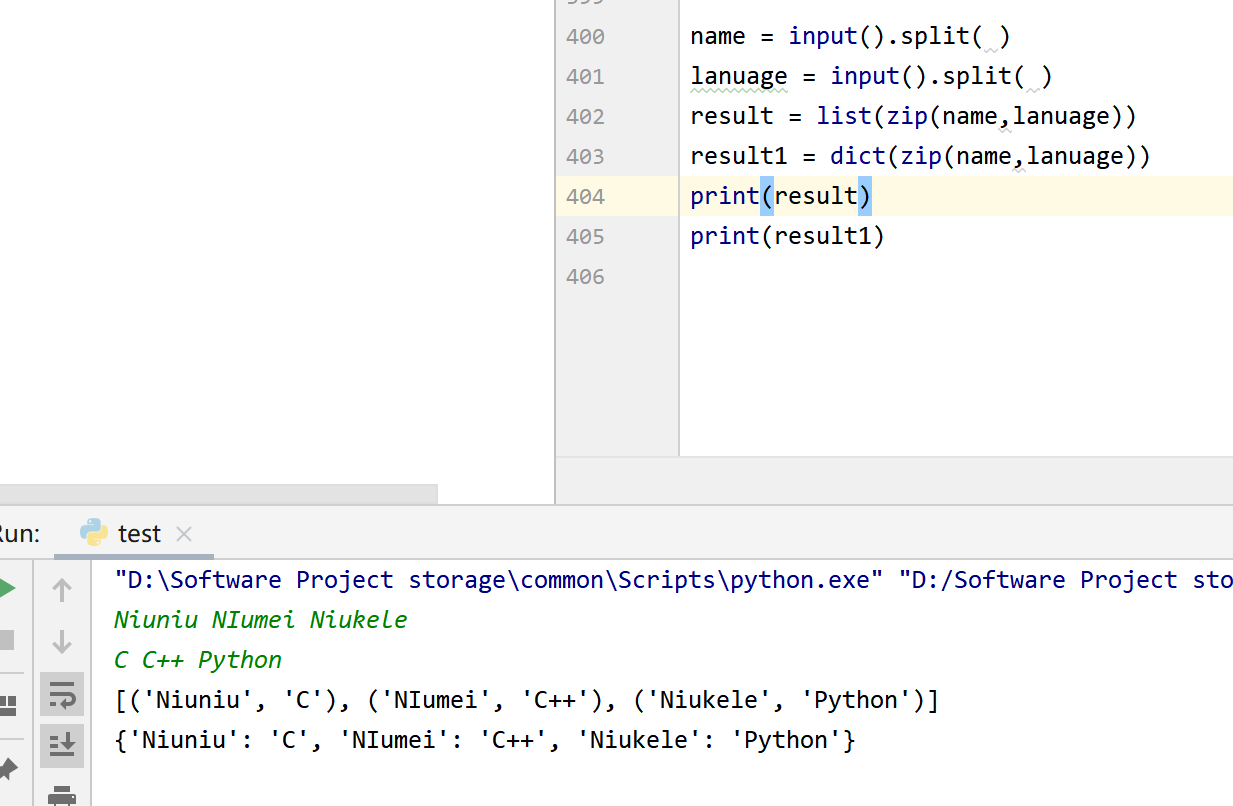
类方法和实例方法
实例方法
在类中定义,以self为第一个参数的方法都是实例方法
实例方法在调用时,Python会将调用对象作为self传入
实例方法可以通过实例和类去调用
当通过实例调用时,会自动将当前调用对象作为self传入
当通过类调用时,不会自动传递self,此时我们必须手动传递self
类方法
在类内部使用 @classmethod 来修饰的方法属于类方法
类方法的第一个参数是cls,也会被自动传递,cls就是当前的类对象
类方法和实例方法的区别,实例方法的第一个参数是self,而类方法的第一个参数是cls
实例方法当通过类调用时,不会自动传递self,此时我们必须手动传递self
类方法可以通过类去调用,也可以通过实例调用,没有区别
例子
class A(object):
def test(self):
print('这是test方法~~~ ' , self)
@classmethod
def test_2(cls):
print('这是test_2方法,他是一个类方法~~~ ',cls)
print(cls.count)
a = A()
a.test() 等价于 A.test(a)
A.test_2() 等价于 a.test_2()
json是字典的字符串的格式,两种可以相互转换
内置函数
find count index isalpha、isdigit、isspace pow abs
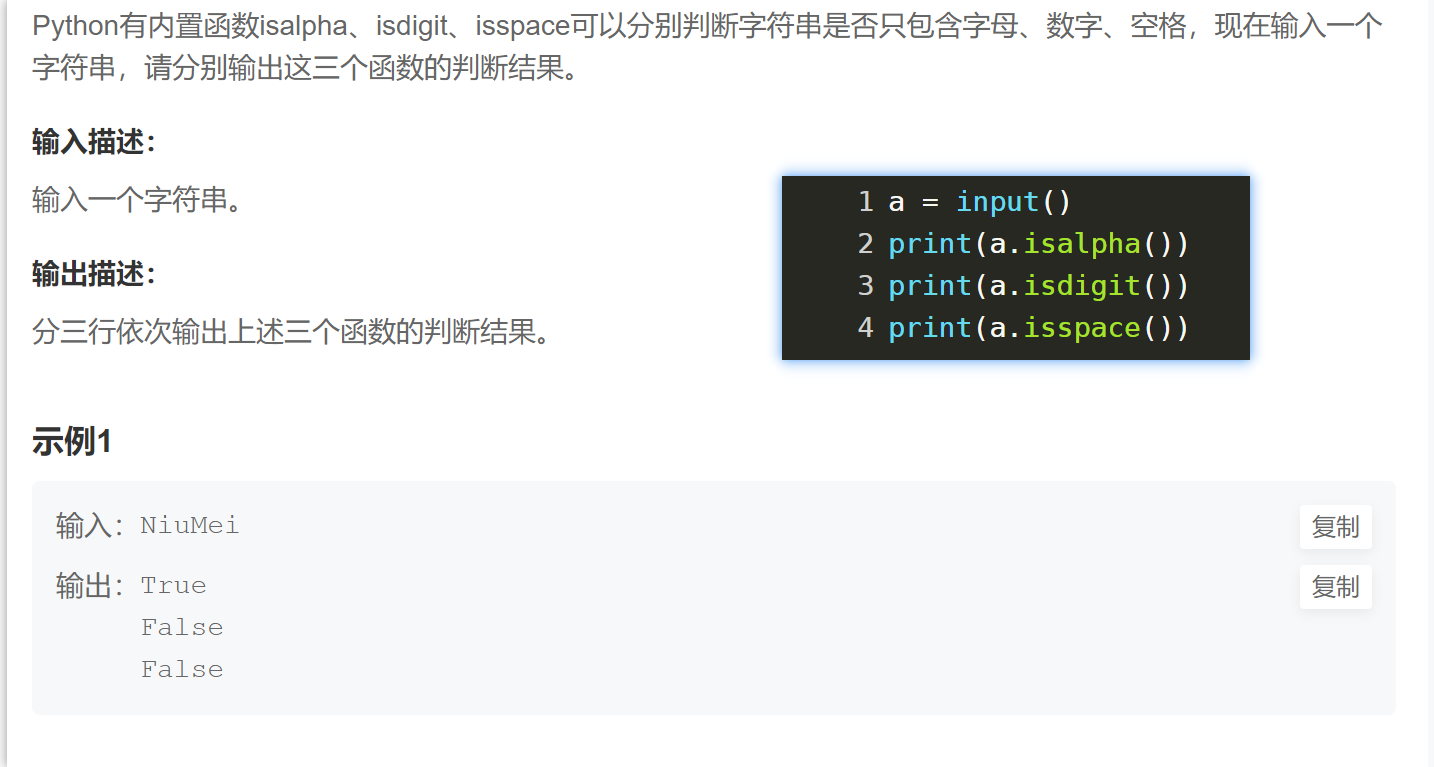
String find count (ps xx.find('The string you are looking for', start, end) returns the first found subscript position and returns -1 if not found)
(ps xx.count('searched string') returns the corresponding number)
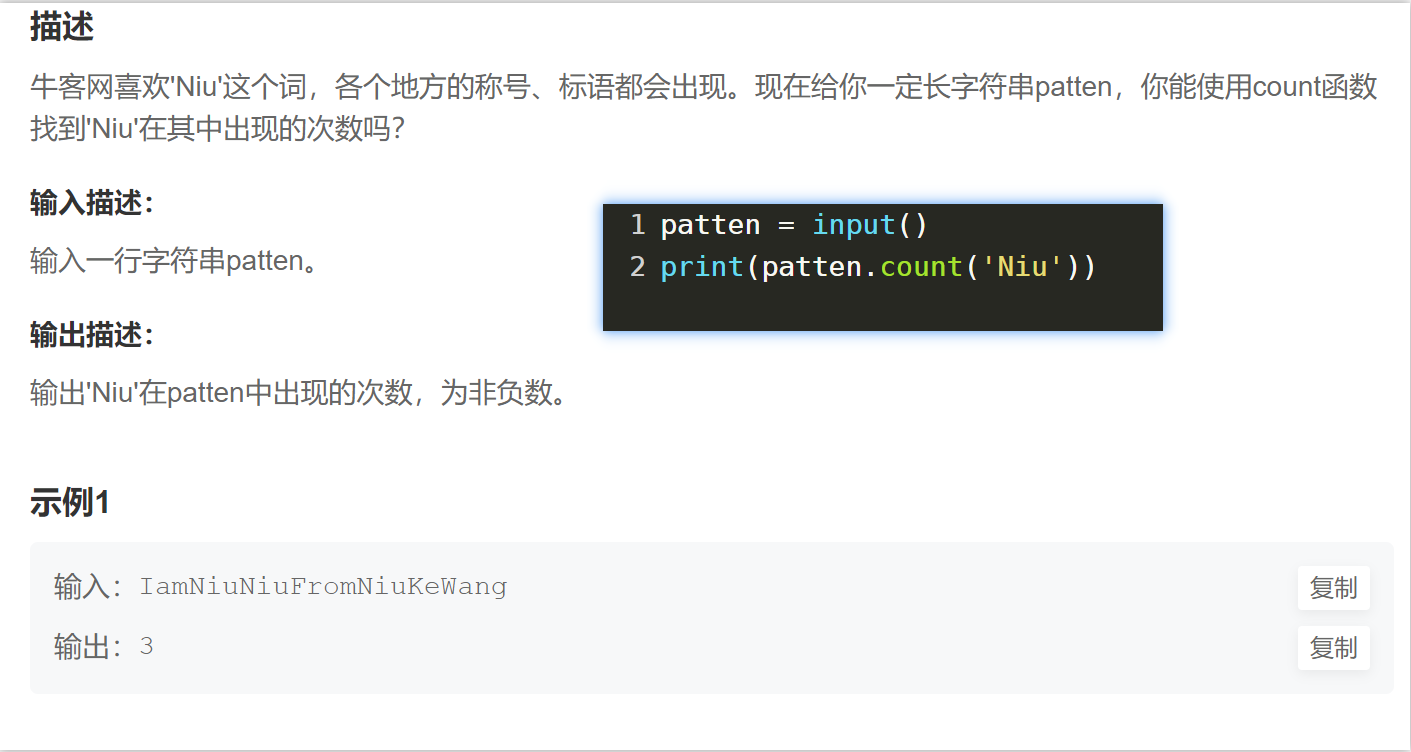
join(ps 'separated by what'. join(xx) xx can be a tuple of string lists)
a = '123456' #也可以是列表或元组
b = ' '.join(a)
print([b]) #['1 2 3 4 5 6']
print(type(b)) #<class 'str'>
round()

eval()
# a = ' 3 * 7 '
# print(eval(a)) #21
Category of website: technical article > Blog
Author:Sweethess
link:http://www.pythonblackhole.com/blog/article/79967/03e1a0d60f8f6cd3dfce/
source:python black hole net
Please indicate the source for any form of reprinting. If any infringement is discovered, it will be held legally responsible.
name:
Comment content: (supports up to 255 characters)
no articles
